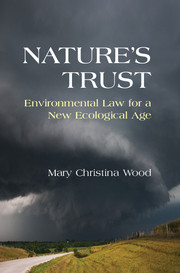Book contents
- Frontmatter
- Dedication
- Contents
- Preface
- Acknowledgments
- Part I Environmental Law: Hospice for a Dying Planet
- Introduction “You Can’t Negotiate with a Beetle”
- 1 “You Are Doing a Great Job”
- 2 Modern Environmental Law: The Great Legal Experiment
- 3 The Politics of Discretion
- 4 Behind the Grand Façade
- 5 The Administrative Tyranny over Nature
- Part II The People’s Natural Trust
- Part III The Public Trust and the Great Transition
- Notes
- Index
4 - Behind the Grand Façade
Published online by Cambridge University Press: 05 June 2014
- Frontmatter
- Dedication
- Contents
- Preface
- Acknowledgments
- Part I Environmental Law: Hospice for a Dying Planet
- Introduction “You Can’t Negotiate with a Beetle”
- 1 “You Are Doing a Great Job”
- 2 Modern Environmental Law: The Great Legal Experiment
- 3 The Politics of Discretion
- 4 Behind the Grand Façade
- 5 The Administrative Tyranny over Nature
- Part II The People’s Natural Trust
- Part III The Public Trust and the Great Transition
- Notes
- Index
Summary
Call it obvious: big money rides on many environmental and land-use decisions, and industries have strong incentives to defeat regulation at every possible turn. Doing so becomes an inextricable part of corporate business – it is called regulatory affairs. As Chapter 3 explained, industry groups mount aggressive antiregulatory campaigns directed at the executive branch of government, which holds permitting authority under environmental statutes.
An antiregulatory campaign works like a well-oiled machine, each part creating powerful torque. As this chapter explains, industry leaders prevail upon state governors as well as the president to place their loyalists in the highest ranks of agencies. They deploy public-relations campaigns to calm the public about the harm caused by their toxic chemicals and harmful practices. They hire and dispatch paid “experts” to produce skewed studies disguised as objective “science,” which portray minimal risk from their industrial practices. They even create professional-looking journals in which to publish the drummed-up science. And moving upstream to the headwaters of the science that threatens to expose their harm, they attack legitimate, credentialed scientists through lawsuits and relentless criticism, seeking to damage their credibility and careers through harassment campaigns that can persist for years.
- Type
- Chapter
- Information
- Nature's TrustEnvironmental Law for a New Ecological Age, pp. 84 - 102Publisher: Cambridge University PressPrint publication year: 2013



